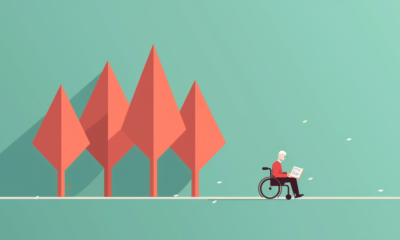SOCIAL
AI Creation Tools Will Change the Way We Create, Engage and Interact in 2023

AI tools are going to have a much bigger influence over many aspects of online communication in 2023, in good ways and bad. And while everyone’s excited to check out what they might look like in various art styles, and how generative systems can reduce their content creation workload, it is worth noting the various impacts, and how these tools can be of both benefit and detriment in your digital marketing efforts.
Content creation
Maybe the most obvious usage of AI creation tools for marketing, as noted, is text-based content, with tools like ChatGPT potentially making it much easier to quickly create massive clusters of blog posts and web pages to help in your SEO efforts.
And it likely can help in this respect. The outputs of ChatGPT, and other text generation tools, are generally readable, competent summaries of a given subject, and with the right text inputs, they can be aligned to certain keywords that will help to ensure that your website meets what Google’s crawlers are seeking, in regards to relevant queries.
But you do need to consider a couple of things. For one, ‘competent’ and ‘good’ are not the same thing, and your visitors will notice.
In the example above, the writing here is fine, the language is functional – it does all the things that it needs to do. I can edit it a bit more to freshen it up, but at base, it’ll probably work.
I suspect that many, many websites will take this approach in future, and they’ll end up using generic overviews like this on their web pages. Which is likely not much worse than the current state of the web – I mean, these tools take in examples from across the current web, then repurpose the language into new presentations, so logically, it’s a very close replica of everything else online.
The end result, then, is that people – like, actual, real humans – will be less and less engaged by the generic, which could open up more opportunity for better copy to stand out, and make your brand more of a useful, helpful resource along the same lines.
Essentially, these tools can be useful for replicating what’s already out there, but if you want anything fresh or new, or even engaging, you’re probably better off creating your own.
But if SEO is your goal, and you want to cut down on time, then this could be an option.
In terms of legal use, you can use ChatGPT outputs, though the requirements do note that you have to make it clear that the content was created by AI, not a human, on the page.
There’s also this qualifier:
“Due to the nature of machine learning, Output may not be unique across users and the Services may generate the same or similar output for OpenAI or a third party. For example, you may provide input to a model such as “What color is the sky?” and receive output such as “The sky is blue.” Other users may also ask similar questions and receive the same response. Responses that are requested by and generated for other users are not considered your Content.”
So, you could also end up copying someone else’s work, which, in itself, can lead to Google penalties for duplicate content.
You can probably get around this by conducting a search using the generated text, or using a tool like Copyscape, but essentially, if you’re putting your text output into the hands of a machine learning system, there could be some usage concerns – aside from pretty bland copy.
I’ve played with ChatGPT a bit, and I’ve tried it out with various article ideas and concepts. None of those outputs, on my reading, have been something that I would publish. The text is fine, it’s, again, functional. But when you’re training a system on billions of pages of bland text from the web, what it’ll ultimately produce, understandably, is going to also be bland, flat prose.
Basically, if you’re okay with your website being like every other web page, if you’re happy with the reading experience of brochures and blog posts, and if you think other brands in your niche have fine text elements, then this is probably fine to you too.
There are different purposes and approaches, but you can’t expect an AI system to give you engaging insight.
Image Production
The other big AI tool usage is in visual creation, and getting tools like Dall E to produce your visuals for you, based on prompts.

And again, it works. You enter what you want, and Dall E will generally come up with at least a few examples that will probably work for what you need.
But the same as text, it won’t be amazing, in general. Functional, yes, it will do the things, but also likely a little bit off, with frayed edges, weird text, strange eyes, etc.
Similar to text outputs, you can legally use image AI outputs for whatever you like, as any image that you create has technically never existed before you entered your text prompt. So, the copyright technically goes to the creator, and as it was your prompt that ‘created’ it, that’s you.
There’s a heap of ways in which this can be useful, and valuable, and many people are already using AI generated artwork to accompany their blog posts and content. It can be useful, but again, it’s literally generic – each images you get is based on a generalization of every other image that the system can find, based on your text prompts.
It depends on how you go about it, and what you want to use these visuals for, but similar to text, there can be duplication concerns (Dall E advises users not to create images of public figures, for example, to avoid misrepresentation concerns), while various legal cases are now being filed over the misappropriation of artists’ work (there’s currently no legal framework that truly covers this type of use).
But they can be valuable, in saving time and money, and it is worth at least checking out Dall E, and other visual creation tools, to see what they produce, based on your prompts.
AI Tweets?
This, at least in my opinion, is where things could get bland pretty quick.
This week, some new tools have emerged aligned with Twitter specifically, which can produce AI generated tweets and replies for your account/s.
Some are using ChatGPT, for example, to produce ‘thinkfluencer’ type tweets, and essentially automate their online persona – which seems problematic, in various ways. What if somebody actually wants to speak to you in person, based on your tweets, and you’re not who you’ve represented in these exchanges? What possible opportunities could arise from using automated tweets, which are not your original thoughts or ideas?
But worse than this, as you’ll note in the above example, such tools could also be used to create tweets complaining about a company.
How long will it be till bot armies are using these processes to attack competitors, at the behest of paying brands? Using generative AI, you could quickly come up with thousands of variations of credible, seemingly real complaints about a business, which could then influence public perception, and harm a brand’s reputation online.
That seems like a more effective, and less detectable approach than the current cut and paste messaging that many bot networks employ.
I suspect that this will become a bigger problem in 2023, as more brands realize the potential for trashing competitors via AI created tweets.
How you police that, I don’t know – especially given Twitter’s ongoing problems in dealing with bot accounts.
AI Generated 3D Models
The latest AI generation tools on the market now also enable users to create 3D models based on simple prompts, which could have big implications for the next stage.

As reported by TechCrunch:
“OpenAI open sourced Point-E, a machine learning system that creates a 3D object given a text prompt, can produce 3D models in one to two minutes on a single Nvidia V100 GPU.”
The next stage of digital connection, be it in the metaverse, VR or AR environments, will all require 3D models, as a means to build the experience, and facilitate interaction in multi-dimensional spaces.
The challenge in this sense is that it requires development expertise and skill, it requires years of knowledge of 3D creation and rendering in order to build these objects and experiences.
Unless it doesn’t.
Every platform with an interest in the next stage is now developing simplified 3D creation tools, with a particular focus on helping brands to scan in their products for AR/VR promotions.
What if AI could do that for you? What if, based on simple prompts, and maybe 2D image examples, AI tools could eventually help you build a corpus of 3D objects for such use?
There’s huge potential here, and it’s becoming increasingly possible to imagine a VR world where you would be able to build entirely new experiences before your eyes, based on simply vocalizing what you want to see.
It’s amazing to consider the potential, and how this could change the way we interact. And while the results of AI tools won’t always blow you away just yet, the fact that these processes are even possible at all is significant, and points to massive opportunities in future use.
AI tools are going to keep getting better, they’ll keep improving, which will lead to more use cases and potential over time. The only restriction, at least right now, is that they can only base their outputs on things that already exist – which means that they’ll always, by design, be at least somewhat generic.
But someday soon, that too will change, and AI tools will be able to create all new content and concepts, beyond what we already know.
Which seems a little scary, but it could also be the true ‘unlock’ that shifts these tools into entirely new territory.
SOCIAL
Snapchat Explores New Messaging Retention Feature: A Game-Changer or Risky Move?

In a recent announcement, Snapchat revealed a groundbreaking update that challenges its traditional design ethos. The platform is experimenting with an option that allows users to defy the 24-hour auto-delete rule, a feature synonymous with Snapchat’s ephemeral messaging model.
The proposed change aims to introduce a “Never delete” option in messaging retention settings, aligning Snapchat more closely with conventional messaging apps. While this move may blur Snapchat’s distinctive selling point, Snap appears convinced of its necessity.
According to Snap, the decision stems from user feedback and a commitment to innovation based on user needs. The company aims to provide greater flexibility and control over conversations, catering to the preferences of its community.
Currently undergoing trials in select markets, the new feature empowers users to adjust retention settings on a conversation-by-conversation basis. Flexibility remains paramount, with participants able to modify settings within chats and receive in-chat notifications to ensure transparency.
Snapchat underscores that the default auto-delete feature will persist, reinforcing its design philosophy centered on ephemerality. However, with the app gaining traction as a primary messaging platform, the option offers users a means to preserve longer chat histories.
The update marks a pivotal moment for Snapchat, renowned for its disappearing message premise, especially popular among younger demographics. Retaining this focus has been pivotal to Snapchat’s identity, but the shift suggests a broader strategy aimed at diversifying its user base.
This strategy may appeal particularly to older demographics, potentially extending Snapchat’s relevance as users age. By emulating features of conventional messaging platforms, Snapchat seeks to enhance its appeal and broaden its reach.
Yet, the introduction of message retention poses questions about Snapchat’s uniqueness. While addressing user demands, the risk of diluting Snapchat’s distinctiveness looms large.
As Snapchat ventures into uncharted territory, the outcome of this experiment remains uncertain. Will message retention propel Snapchat to new heights, or will it compromise the platform’s uniqueness?
Only time will tell.
SOCIAL
Catering to specific audience boosts your business, says accountant turned coach

While it is tempting to try to appeal to a broad audience, the founder of alcohol-free coaching service Just the Tonic, Sandra Parker, believes the best thing you can do for your business is focus on your niche. Here’s how she did just that.
When running a business, reaching out to as many clients as possible can be tempting. But it also risks making your marketing “too generic,” warns Sandra Parker, the founder of Just The Tonic Coaching.
“From the very start of my business, I knew exactly who I could help and who I couldn’t,” Parker told My Biggest Lessons.
Parker struggled with alcohol dependence as a young professional. Today, her business targets high-achieving individuals who face challenges similar to those she had early in her career.
“I understand their frustrations, I understand their fears, and I understand their coping mechanisms and the stories they’re telling themselves,” Parker said. “Because of that, I’m able to market very effectively, to speak in a language that they understand, and am able to reach them.”Â
“I believe that it’s really important that you know exactly who your customer or your client is, and you target them, and you resist the temptation to make your marketing too generic to try and reach everyone,” she explained.
“If you speak specifically to your target clients, you will reach them, and I believe that’s the way that you’re going to be more successful.
Watch the video for more of Sandra Parker’s biggest lessons.
SOCIAL
Instagram Tests Live-Stream Games to Enhance Engagement

Instagram’s testing out some new options to help spice up your live-streams in the app, with some live broadcasters now able to select a game that they can play with viewers in-stream.
As you can see in these example screens, posted by Ahmed Ghanem, some creators now have the option to play either “This or That”, a question and answer prompt that you can share with your viewers, or “Trivia”, to generate more engagement within your IG live-streams.
That could be a simple way to spark more conversation and interaction, which could then lead into further engagement opportunities from your live audience.
Meta’s been exploring more ways to make live-streaming a bigger consideration for IG creators, with a view to live-streams potentially catching on with more users.
That includes the gradual expansion of its “Stars” live-stream donation program, giving more creators in more regions a means to accept donations from live-stream viewers, while back in December, Instagram also added some new options to make it easier to go live using third-party tools via desktop PCs.
Live streaming has been a major shift in China, where shopping live-streams, in particular, have led to massive opportunities for streaming platforms. They haven’t caught on in the same way in Western regions, but as TikTok and YouTube look to push live-stream adoption, there is still a chance that they will become a much bigger element in future.
Which is why IG is also trying to stay in touch, and add more ways for its creators to engage via streams. Live-stream games is another element within this, which could make this a better community-building, and potentially sales-driving option.
We’ve asked Instagram for more information on this test, and we’ll update this post if/when we hear back.
-

 PPC4 days ago
PPC4 days ago19 Best SEO Tools in 2024 (For Every Use Case)
-

 PPC7 days ago
PPC7 days ago4 New Google Ads Performance Max Updates: What You Need to Know
-

 MARKETING7 days ago
MARKETING7 days agoWill Google Buy HubSpot? | Content Marketing Institute
-
SEARCHENGINES6 days ago
Daily Search Forum Recap: April 16, 2024
-

 SEO6 days ago
SEO6 days agoGoogle Clarifies Vacation Rental Structured Data
-

 MARKETING6 days ago
MARKETING6 days agoStreamlining Processes for Increased Efficiency and Results
-
SEARCHENGINES5 days ago
Daily Search Forum Recap: April 17, 2024
-

 PPC7 days ago
PPC7 days agoHow to Collect & Use Customer Data the Right (& Ethical) Way














You must be logged in to post a comment Login